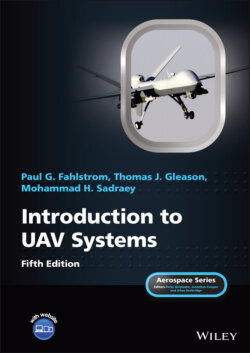Читать книгу Introduction to UAV Systems - Mohammad H. Sadraey - Страница 78
3.11 Total Air‐Vehicle Drag
ОглавлениеThe total resistance to the motion of a subsonic air‐vehicle wing is made up of two components: the drag due to lift (induced drag) and the profile drag, which in turn is composed of the friction drag and the pressure drag (due to flow separation). For the overall air vehicle, the drag of all the non‐lift parts (e.g., fuselage, landing gear, and payload) are lumped together and called parasite (or parasitic) drag. If the various drag components are expressed in terms of drag coefficients, then simply multiplying their sum by the dynamic pressure (q) and a characteristic area (usually the wing area, S) results in the total drag:
(3.14)
where CDo is the sum of all the profile drag coefficients (it is also referred to as the zero‐lift drag coefficient) and CDi is the induced drag coefficient, whose quadratic form results in the parabolic shape of the polar curve (see Figure 3.13).
The ScanEagle UAV – developed by Boing Insitu – is composed of four field‐replaceable major modules/components: (1) nose (including payload sensors), (2) fuselage, (3) Wing, and (4) prop‐driven engine. The UAV has a cylindrical fuselage of 2 m long with a mid‐mounted swept‐back wing with winglets, endplate vertical tail and movable rudders. The nose carries a pitot tube, which is fitted with an anti‐precipitation system for cold weather operation. The air vehicle is fitted with a pusher piston engine (0.97 kW) with a two‐blade propeller. All of these external components contribute to the total vehicle drag.
Moreover, the internal components include avionics, autopilot, communication system, fuel system, and mechanical/electric systems. The nose houses a gimballed and inertially stabilized turret which is fitted with EO/IR cameras. The air vehicle is not fitted with landing gear. The vehicle carries a maximum of 4.3 kg of fuel.
